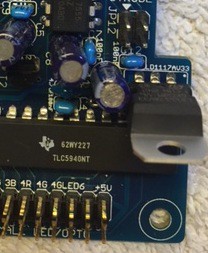Thanks for the pointer to the DOF Tester tool. I have been using it to successfully test both the Flipper and Small Opto outputs. Everything looks great so far, for ports 1 - 32 at least.
Can I also use this tool to test the LEDWiz ports above 32? The documentation implies that I can. I am looking for something simple to reach out and tickle the MOSFET and CHIME boards. Right now "DirectOutputTest.exe 8 33 1" reports "Output ID ## out of range (must be 1-32)" for every LEDWiz port above 32. (## is a LEDWiz port number between 33 and 64.) On the other hand, "DirectOutputTest.exe 58 33 1" exits without error. At this point, I am pretty sure I need to be using Unit 58, not unit 8. The trouble is that I am seeing no change in activity on the MOSFET board. Stay tuned - I'll figure this one out.
Be aware there is a part position swap on the Chime board, Channels 5 and 6 appear to have identical component placement. Both channels have NPN transistors - T9 and T12; and PNP transistors - T10 and T13. If you look closely at the Chime PCB, you will see T12 and T13 swapped in reference to T9 and T10. An even closer look reveals distinctly different routing between the two channels to accommodate this swap. Unfortunately, I did not catch this until I began bench testing the board. The good news is the other 7 channels work flawlessly.
If you are using the Chime board, there are no "HC595_PORT" channels assigned to a LEDWiz channel in "config.h". For testing I made the following alterations. Basically, I reassigned LEDWiz port numbers 25-32 from their various general purpose TLC ports to HC595 ports (The // in a line makes what follows on that line a comment.). I likely will not leave them this way as I build out my cabinet - this is just for testing.
{ 1, HC595_PORT }, // HC595 port 1, LW output 25
{ 2, HC595_PORT }, // HC595 port 2, LW output 26
{ 3, HC595_PORT }, // HC595 port 3, LW output 27
{ 4, HC595_PORT }, // HC595 port 4, LW output 28
{ 5, HC595_PORT }, // HC595 port 5, LW output 29
{ 6, HC595_PORT }, // HC595 port 6, LW output 30
{ 7, HC595_PORT }, // HC595 port 7, LW output 31
{ 8, HC595_PORT }, // HC595 port 8, LW output 32
// { 24, TLC_PORT }, // TLC port 24, LW output 25 - Contactor 4/General purpose
// { 25, TLC_PORT }, // TLC port 25, LW output 26 - Contactor 5/General purpose
// { 26, TLC_PORT }, // TLC port 26, LW output 27 - Contactor 6/General purpose
// { 27, TLC_PORT }, // TLC port 27, LW output 28 - Contactor 7/General purpose
// { 28, TLC_PORT }, // TLC port 28, LW output 29 - Contactor 8/General purpose
// { 29, TLC_PORT }, // TLC port 29, LW output 30 - Contactor 9/General purpose
// { 30, TLC_PORT }, // TLC port 30, LW output 31 - Contactor 10/General purpose
// { 31, TLC_PORT }, // TLC port 31, LW output 32 - Shaker Motor/General purpose
Bottom line this far is both the Main board and most of the Chime board work perfectly (all except channel 6). The MOSFET board still needs work.
Cheers!





 Top
Top












 are all trademarks of VPFORUMS.
are all trademarks of VPFORUMS.